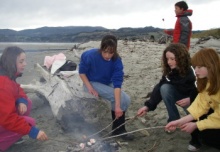Circle time
From WikiEducator
Contents
Circle time
“Circle time” taking place once a week at schools and other learning centres
Circle time - what it isn't
- It isn’t therapy, it isn’t a forum for behaviour intervention, and it certainly isn’t the place for judgement or coercion!
Circle time - what it is
- It is a space within the curriculum into which each person comes with unconditional acceptance which provides an opportunity to learn and explore through the discussion of experiences and individuality
- It is a time where people can talk safely without fear of embarrassment or ridicule
- It’s a space in which people can learn the skills to thrive - effective communication, emotional literacy, anger management, peer mediation and conflict resolution....
- These may have a positive impact on personal behaviour management, but this is a side-effect rather than a goal!
Even the most beautiful angels can still benefit from circle time
Spin-offs from circle time
Educators using circle time report observing these benefits:
- Increased levels of self-motivation among students
- Enhanced communication between students and staff
- Greater social and community awareness
- Enhanced self-esteem and self-respect
- Greater skills of assertion
- Increased ability to empathise with others
- Heightened abilities to behave altruistically
- Strengthened resilience in students
- Circle time is to school what the meal table is to the home, a place where people talk to each other openly, pleasantly and safely
- Where social skills are practised and developed
- Where we learn to be human
Circle time rules
- Student directed - e.g
- Hands up or out to talk, one at a time speaking, eye contact to speaker, keep still, others...
- Asking someone to cease an annoying behaviour:
- Eye contact, nodding head
- Quietly using their name
- Asking politely for them to stop etc
- Quietly using their name
- Eye contact, nodding head
Circle Time - themes
- If students are not ready for self initiated conversation here some good starters
- Today's headline, a piece of graffiti - art?, amazing animal, walking, what makes a friend?, respect, leadership, tastiest meal, cartoon characters, making money, fruit sculpture...the topics are endless!
best to warm-up with a game or two before starting conversations
Circle Time - games
- Fruit salad, soup, farmyard, zoo - choosing 3 or 4 components from one of the themes, name off children around the circle. Apple, orange, cherry - when 'Cherry" is called out the students who are Cherries stand up and change seats. When "Fruit Salad" is called out everyone stands up and changes seats.
- Mixes up the seating or standing arrangements
- Granny's/grandpa's knickers - students try and make another student smile
- Questions - What did you eat for breakfast
- Answer - Granny's knickers (smile and out)
- Questions - What did you eat for breakfast
Other Circle time warm ups and end games
- Clapping
- Going round the circle one clap continues the direction, 2 changes the direction back.
- Keys
- One child stands in the middle of the circle blindfolded. The other children pass something noisy around the circle. When the child in the middle thinks they know where the keys are they shout ‘stop!’ and point in that direction.
- Shopping
- ‘I went to the shops and bought…’ each child remembers the previous items and adds one of their own.
- Birthdays
- Call a month of the year, children whose birthdays are in that month, run around the circle back to their original chair.
- Words
- Start with a word and 2 claps in between, the next child must say a word associated to the start, e.g. tree, clap, clap, leaf, clap, clap, caterpilla
- Squeeze (Mexican wave)
- Hold hands around the circle, and pass a gentle squeeze from hand to hand.
- Smile
- A smile is passed around the circle.
- Arm link
- Say a number, the children have to link up with the correct number in their group, then cross the circle linked.
- Hunt the pair
- Prepare paired picture cards, e.g. bucket and spade, each child takes a card, then must find their pair without speaking.
- Musical islands
- Place large sheets of newspaper on the floor, when the music stops all feet must be on the paper. Slowly take the pieces of paper away.
- I know your name
- Take turns to call someone’s name and swap seats, continue until everyone has been called.
- Dracula
- A child is Dracula, they say a victims name and start to walk towards them, the victim must say another name to change the victim, and Dracula changes direction towards the new victim, if a victim is caught, they become Dracula.
- 99
- A child leaves the room while someone is nominated. When the child enters the room they stand in the middle of the circle, the nominated child says ‘99’, trying to disguise their voice. The first child tries to guess who spoke.
- Chinese mimes
- All stand facing the back of the person in front, with eyes closed. The leader taps the person in front on the shoulder, when they turn around mime an action. The mime is passed around the circle.
- Remote control
- Children suggest actions for some of the buttons on a remote control when that button is pressed they perform the action.
- Body to body
- Group children around the circle; say how they must be joined, e.g. finger-to-finger. Children carry out commands.
- Follow the leader
- The leader begins miming and action; clapping, etc. the others in the circle must copy. Change leader after 2 or 3 actions.
- Introductions
- Introduce yourself and the person sitting next to you. Continue around the circle.
- What am I?
- Choose a positive adjective to describe yourself, go around the circle in turn e.g wandering, wacky, woolly
- Who are we?
- One child says their name and points to another child, who stands up and repeats until all are standing.
- Colours
- If I were a colour, I would be … because…
- Listening
- All close eyes and listen for 2 minutes, then go around the circle to say what sounds were heard.
- Instruments
- If I were an instrument, I would be… because…
- Storm
- Leader starts by wiggling fingers for the rain, this passes around the circle until everyone is wiggling their fingers. The leader then changes the action to other aspects of the storm, e.g. wind – arms waving, thunder – slap knees. End with the sun - mime a circle.
- Mirrors
- In pairs A/B A is the leader, B is the mirror and must copy the actions, go slowly at first. Swap roles.
- Belonging game
- Make enough cards for each child to have one, make 3 or 4 with each number from 1-5, then one of each number 6,7,8. Children must not talk, but must find the others in their groups, when they find a fellow number, they must act very pleased to see them and continue walking as if a group, when all members are found sit down. If someone with a different number tries to join, act as if they are not welcome. Talk about the feelings of belonging, how it felt to be left out, how it felt to reject others.
- Changes
- Someone goes outside, 2 people in the circle swap places, and the outsider tries to guess who has moved.
- A sticky situation
- One person in middle calls out ‘Help, help! Others reply ‘What’s the matter?’ first person makes up a situation: e.g. stuck up a ladder, chased by killer bees. Others reply ‘Who do you want to help?’ first person makes up random criteria: e.g. tallest, kindest, best at tables. Others nominate person to help, they swap places with one in middle. All good at different things, we can all help each other.
- Feelings
- Child takes a feelings card and an action card, e.g. eating dinner – excited. Child acts in appropriate manner, others guess. Children could make up on feelings and actions.
- How do you do?
- Play music, children move around room. When the music stops children greet each other (any culturally appropriate greeting) then ask each other one question, eg what do you like doing? What is your favourite colour?
- Building community
- Say ‘come into the circle and join hands if you… (have long hair, wear glasses)’ continue until most in circle, end with ‘come into the circle if you are in class…’ All shout ‘We are!’
- Hello, how are you?
- One child crosses the circle to shake hands and ask a question, then returns to their place. The questioned child then crosses the circle.
- The lining up game
- Without help, the children need to line up quickly in: register order, birthday month order, house number order (if the house only has a name it counts as 0).
- Hedgehogs
- Move around the room to the music, when the music stops children curl up on the floor like hedgehogs. Put a curtain over one child, the others stand up and guess who is under the curtain. Return to seats and share a round to say what we like about the curtained hedgehog.

